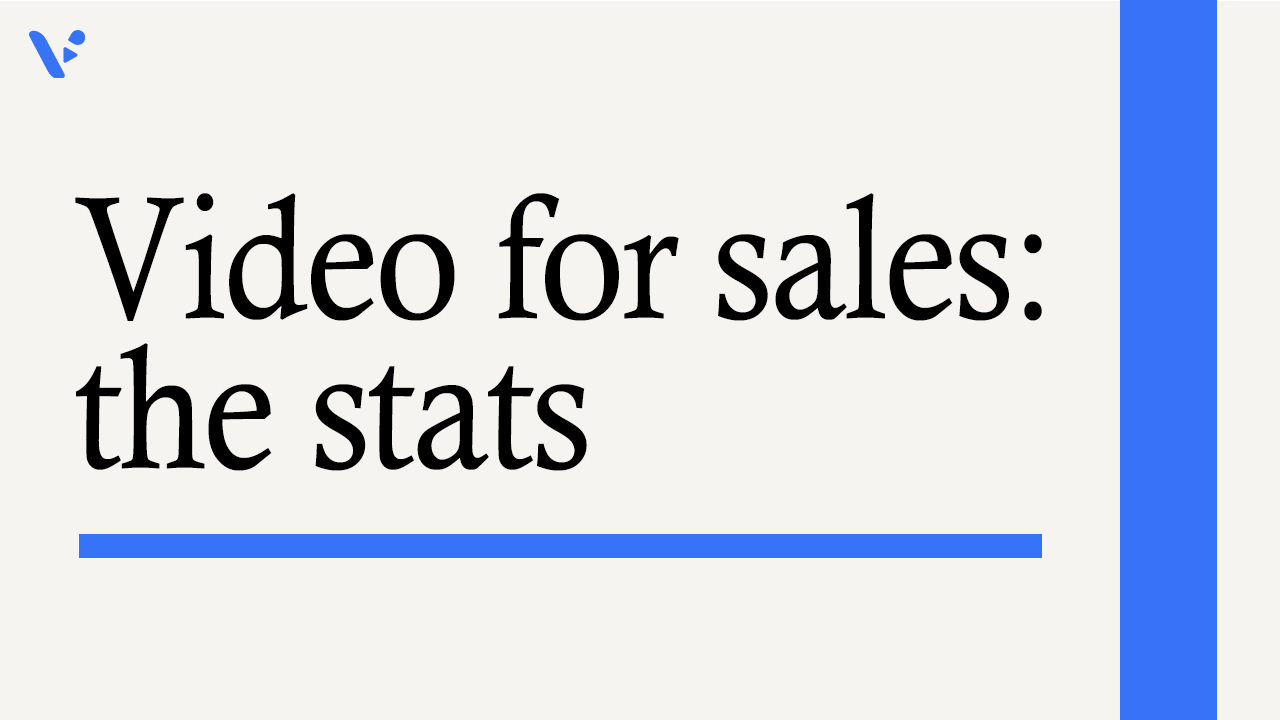Video is rapidly becoming an essential tool in B2B sales. Sales teams are using video to connect with prospects, showcase products, and keep deals moving forward, and the numbers speak for themselves. In fact, 87% of marketers say video has a direct positive impact on sales, and 89% believe their business would benefit from using video more. Buyers appreciate it too: 87% of customers claim video helped them make a buying decision.

With stats like these, it’s no surprise that B2B marketers plan to ramp up video content more than any other format in 2024. Video isn’t just a trendy add-on; it’s driving better outcomes across the sales process.
Cold prospecting that actually gets attention
Reaching out to new prospects is tough – most cold emails get ignored. Video can change that by adding a personal, human touch that cuts through the noise. Research shows that using video in prospecting dramatically improves response rates and engagement. For example:
- A video message is 10× more likely to elicit a response from a prospect than plain text outreach. Just seeing a face or hearing a voice builds more trust than a written email.
- Including video boosts cold email performance, lifting open rates by 16% and reply rates by 26% in one analysis. Prospects are more likely to open and respond when there’s a video inside.
- In multi-touch sales campaigns, sequences that started with a video outperform others by 400%, accounting for 83% of all opportunities generated. In other words, kicking off your outreach with a video can quadruple your pipeline creation compared to text-only tactics.
These numbers underline how powerful video prospecting can be. Real-world sales teams back it up: HubSpot’s sales team experimented with personalized video outreach and quadrupled their sales opportunities as a result. Video helps reps break out of the inbox clutter by showing genuine personality and effort. A short tailored video, even a simple selfie-style recording, makes the prospect feel like you’re speaking directly to them, not sending a templated blast. This builds rapport early. In fact, 94% of sales professionals say video helps build buyer confidence in the seller. Prospects start to see you as a real person offering real value, rather than just another cold email.
Just as importantly, video can convey information faster and more clearly than text. You can pack a lot of pitch into a 60-second video that might take several paragraphs to write out. Prospects appreciate the brevity and clarity. No wonder 73% of people say they prefer learning about a product through short videos over text. By giving prospects content in the format they like, you make it easier for them to engage. All these factors lead to better outcomes at the top of the funnel and more conversations and meetings from your outreach efforts.
Show, don’t tell: using video for your product demos
When it comes to explaining a complex B2B product or service, seeing is believing. That’s why product demo videos are one of the most popular and effective tools in B2B sales. Rather than sending over a dense slide deck or hoping a prospect reads a long email, many sales teams record quick demo videos or screen shares to showcase their solution in action. This approach can scale your reach and make your pitch more compelling.
Consider these insights on product videos in B2B sales:
- B2B companies heavily favor product-focused videos. The most common video types produced by B2B teams are product demo and product overview videos. In one survey, 48% of marketers said product demos were among their most created video content types. Clearly, sales and marketing teams recognize how vital demos are for educating buyers.
- Buyers respond strongly to product videos. 87% of people say a video convinced them to buy a product or service at least once. And in the software world, 74% of app buyers say their purchase decision was influenced by video content. Busy decision-makers often prefer to watch a 2-minute product demo video rather than schedule a live demo or sift through PDFs. A well-crafted demo video can deliver the value proposition and key features in an easily shareable format.
- Video demos can accelerate the sales cycle. Prospects who view a demo video come into sales calls more informed and interested. According to data, including a demo or explainer video during prospecting helped deals close 26% faster on average. Faster closings likely result from prospects having a clearer understanding of the product up front, so fewer meetings are needed to address basic questions. It also helps get all stakeholders on the same page. If one champion at the target company sees the video, they can forward it internally, effectively demoing your product to others on the buying committee without you having to coordinate multiple live presentations.
By leveraging video for product demonstrations, sales reps can efficiently educate many prospects in parallel. One recorded demo can be reused in cold outreach, on your website, and as follow-up material. And it operates on the buyer’s schedule – they can watch it anytime, pause, rewind, or share as needed. This on-demand demo capability is incredibly powerful in B2B sales where multiple decision-makers are involved. It ensures your product’s story is told consistently every time. Given that 50% of B2B firms create training videos and over one-third use testimonial and explainer videos to support their sales process, it’s clear that video has become a backbone for how B2B buyers learn about solutions.
Winning more deals with video proposals
Video’s benefits don’t stop once you’ve caught a lead’s interest, it can be the secret weapon that helps close the deal as well. When you’re in the proposal or final negotiation stage, sending a personalized video can reinforce your message and keep stakeholders engaged. Whether it’s a walkthrough of the proposal document, a quick recap of your value points, or a customer testimonial video, adding rich media to your sales proposal pays dividends.
Consider the impact of using video in proposals and sales quotes:
- Much higher client engagement: Proposals that include at least one video see 56% more engagement from prospective customers. Prospects spend more time reading and interacting with the proposal content when a video is there to grab their attention. For example, an introductory video message at the start of a proposal can summarize the key points and encourage the recipient to dive deeper into the document.
- Faster deal closing: That increased engagement translates into momentum. On average, deals close 26% faster when proposals contain video content. Instead of letting a proposal sit in an inbox, a video prompts the buyer to act. Video humanizes your pitch and often addresses questions or concerns on the spot, reducing back-and-forth. Speed is crucial in sales; a faster close means less chance for competitors to swoop in or for buyer interest to fade.
- Higher conversion rates: Companies that use video in proposals report more proposals turning into signed deals. (In one analysis, adding a single video to a proposal boosted close rates by roughly 41% – a huge lift in win probability.) Video helps make your proposal more persuasive by building an emotional connection and trust. For instance, a short video of a satisfied customer talking about their success can be far more convincing than text alone on a slide.
- Standing out from the pack: Surprisingly few teams use video in their proposals today, despite the advantages. Only about 21% of sales proposals include videos at all. This means adding video is a golden opportunity to differentiate your pitch. Your proposal will immediately feel more modern, tailored, and engaging than the typical bland Word document. For the buyer, it demonstrates extra effort and care on your part. When a prospect is weighing multiple vendors, a personalized video message can be the little nudge that makes your offering more memorable.
Overall, video turns a static proposal into an interactive experience. Instead of just reading about your solution, the buyer sees and hears your enthusiasm, expertise, and commitment. You can guide them through complex concepts or pricing in a friendly way, almost as if you were there in person. This builds confidence – indeed, 91% of sales pros believe video helps overcome objections during the sales process. If a stakeholder has doubts, a video explanation can address it head-on. By the time they finish reviewing your proposal, they feel as if they know you and have clarity on how you will deliver value.
Friendly follow-ups and lasting impressions
In B2B sales, the work isn’t done after sending a proposal or doing a demo. Thoughtful follow-ups are crucial to reassure the buyer, answer last-minute questions, and keep the relationship warm. Here too, video has major benefits. A personable follow-up video (for example, a “thank you for your time” message or a concise Q&A addressing remaining concerns) can leave a positive impression that text alone can’t match.
Here’s how video helps during follow-ups and final negotiations:
- Builds trust and human connection: After several email exchanges and meetings, a follow-up video from the sales rep (or even a team leader or CEO for a big deal) helps put a face to the company. This approach boosts buyer confidence. In fact, 94% of sales professionals say video makes buyers more confident in the seller. The buyer sees that you’re willing to speak directly and transparently, which fosters trust. It shows you stand behind your proposal with personal accountability.
- Reinforces key points and value: You can use a short video to reiterate the main benefits of your solution as a friendly reminder. Because video is engaging, it ensures the message actually gets absorbed. (We know engagement is higher – people tend to watch the videos they’re sent.) This helps prevent “deal drift,” where the prospect loses sight of why they were interested. A video follow-up keeps the excitement up.
- Clarifies doubts and reduces friction: If a prospect has lingering questions or objections (about pricing, implementation, ROI, etc.), addressing them in a video can be far more effective than a long email. You can literally show how an issue will be handled or convey sincerity in your voice. Sales reps report that video is great for this purpose: 91% agree that videos help overcome objections during the sales cycle. It’s easier to explain complex answers verbally with visuals than via text. The result is a smoother final stage with fewer barriers to saying “yes.”
- Assures post-sale support: Another underrated benefit is how video sets the tone for the customer relationship. 86% of marketers believe that video outreach makes prospects feel more confident they’ll receive good support after buying. The prospect gets the sense that your company is communicative, transparent, and will continue to be there in person (through video) when it counts. This peace of mind can be the final push needed for a cautious buyer to sign the contract.
In short, video follow-ups help you be likable and reassuring in those critical moments before a deal closes. It’s like a digital handshake and smile. For a young professional buyer, a casual selfie video saying “Thanks for checking out our proposal – I’m excited to work together and happy to answer any other questions!” comes across as warm and genuine. This approach differentiates you from competitors who may stick to formal, impersonal emails. By leveraging video throughout the sales journey, from initial outreach, product introduction, proposal, to follow-up, you create a cohesive and engaging experience that builds trust at every step.

